Bach1 promotes muscle regeneration through repressing Smad-mediated inhibition of myoblast differentiation
- PMID: 32776961
- PMCID: PMC7416950
- DOI: 10.1371/journal.pone.0236781
Bach1 promotes muscle regeneration through repressing Smad-mediated inhibition of myoblast differentiation
Abstract
It has been reported that Bach1-deficient mice show reduced tissue injuries in diverse disease models due to increased expression of heme oxygenase-1 (HO-1)that possesses an antioxidant function. In contrast, we found that Bach1 deficiency in mice exacerbated skeletal muscle injury induced by cardiotoxin. Inhibition of Bach1 expression in C2C12 myoblast cells using RNA interference resulted in reduced proliferation, myotube formation, and myogenin expression compared with control cells. While the expression of HO-1 was increased by Bach1 silencing in C2C12 cells, the reduced myotube formation was not rescued by HO-1 inhibition. Up-regulations of Smad2, Smad3 and FoxO1, known inhibitors of muscle cell differentiation, were observed in Bach1-deficient mice and Bach1-silenced C2C12 cells. Therefore, Bach1 may promote regeneration of muscle by increasing proliferation and differentiation of myoblasts.
Conflict of interest statement
The authors have declared that no competing interests exist.
Figures

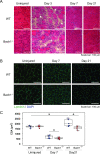
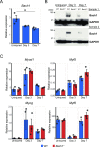
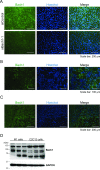

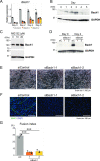
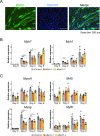
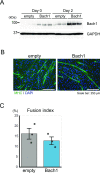
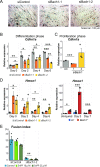
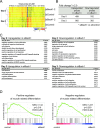
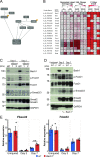
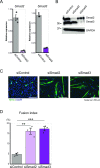

Similar articles
-
Bach1 regulates osteoclastogenesis in a mouse model via both heme oxygenase 1-dependent and heme oxygenase 1-independent pathways.Arthritis Rheum. 2012 May;64(5):1518-28. doi: 10.1002/art.33497. Arthritis Rheum. 2012. PMID: 22127667
-
Palmdelphin promotes myoblast differentiation and muscle regeneration.Sci Rep. 2017 Feb 2;7:41608. doi: 10.1038/srep41608. Sci Rep. 2017. PMID: 28148961 Free PMC article.
-
Bach1 deficiency and accompanying overexpression of heme oxygenase-1 do not influence aging or tumorigenesis in mice.Oxid Med Cell Longev. 2014;2014:757901. doi: 10.1155/2014/757901. Epub 2014 Jun 23. Oxid Med Cell Longev. 2014. PMID: 25050144 Free PMC article.
-
Arkadia represses the expression of myoblast differentiation markers through degradation of Ski and the Ski-bound Smad complex in C2C12 myoblasts.Bone. 2009 Jan;44(1):53-60. doi: 10.1016/j.bone.2008.09.013. Epub 2008 Oct 7. Bone. 2009. PMID: 18950738
-
Bach1-dependent and -independent regulation of heme oxygenase-1 in keratinocytes.J Biol Chem. 2010 Jul 30;285(31):23581-9. doi: 10.1074/jbc.M109.068197. Epub 2010 May 25. J Biol Chem. 2010. PMID: 20501657 Free PMC article.
Cited by
-
Integrative ATAC-seq and RNA-seq Analysis of the Longissimus Dorsi Muscle of Gannan Yak and Jeryak.Int J Mol Sci. 2024 May 30;25(11):6029. doi: 10.3390/ijms25116029. Int J Mol Sci. 2024. PMID: 38892214 Free PMC article.
-
Contribution of the Transcription Factors Sp1/Sp3 and AP-1 to Clusterin Gene Expression during Corneal Wound Healing of Tissue-Engineered Human Corneas.Int J Mol Sci. 2021 Nov 17;22(22):12426. doi: 10.3390/ijms222212426. Int J Mol Sci. 2021. PMID: 34830308 Free PMC article.
-
Skeletal Muscle Regeneration in Cardiotoxin-Induced Muscle Injury Models.Int J Mol Sci. 2022 Nov 2;23(21):13380. doi: 10.3390/ijms232113380. Int J Mol Sci. 2022. PMID: 36362166 Free PMC article. Review.
-
Bleomycin-treated myoblasts undergo p21-associated cellular senescence and have severely impaired differentiation.Geroscience. 2024 Apr;46(2):1843-1859. doi: 10.1007/s11357-023-00929-9. Epub 2023 Sep 26. Geroscience. 2024. PMID: 37751045 Free PMC article.
-
The KEAP1-NRF2 pathway regulates TFEB/TFE3-dependent lysosomal biogenesis.Proc Natl Acad Sci U S A. 2023 May 30;120(22):e2217425120. doi: 10.1073/pnas.2217425120. Epub 2023 May 22. Proc Natl Acad Sci U S A. 2023. PMID: 37216554 Free PMC article.
References
-
- Opar DA, Drezner J, Shield A, Williams M, Webner D, Sennett B, et al. Acute hamstring strain injury in track-and-field athletes: A 3-year observational study at the Penn Relay Carnival. Scandinavian journal of medicine & science in sports. 2014;24(4):e254–9. Epub 2013/12/18. 10.1111/sms.12159 . - DOI - PubMed
Publication types
MeSH terms
Substances
LinkOut - more resources
Full Text Sources
Molecular Biology Databases
Research Materials
Miscellaneous

